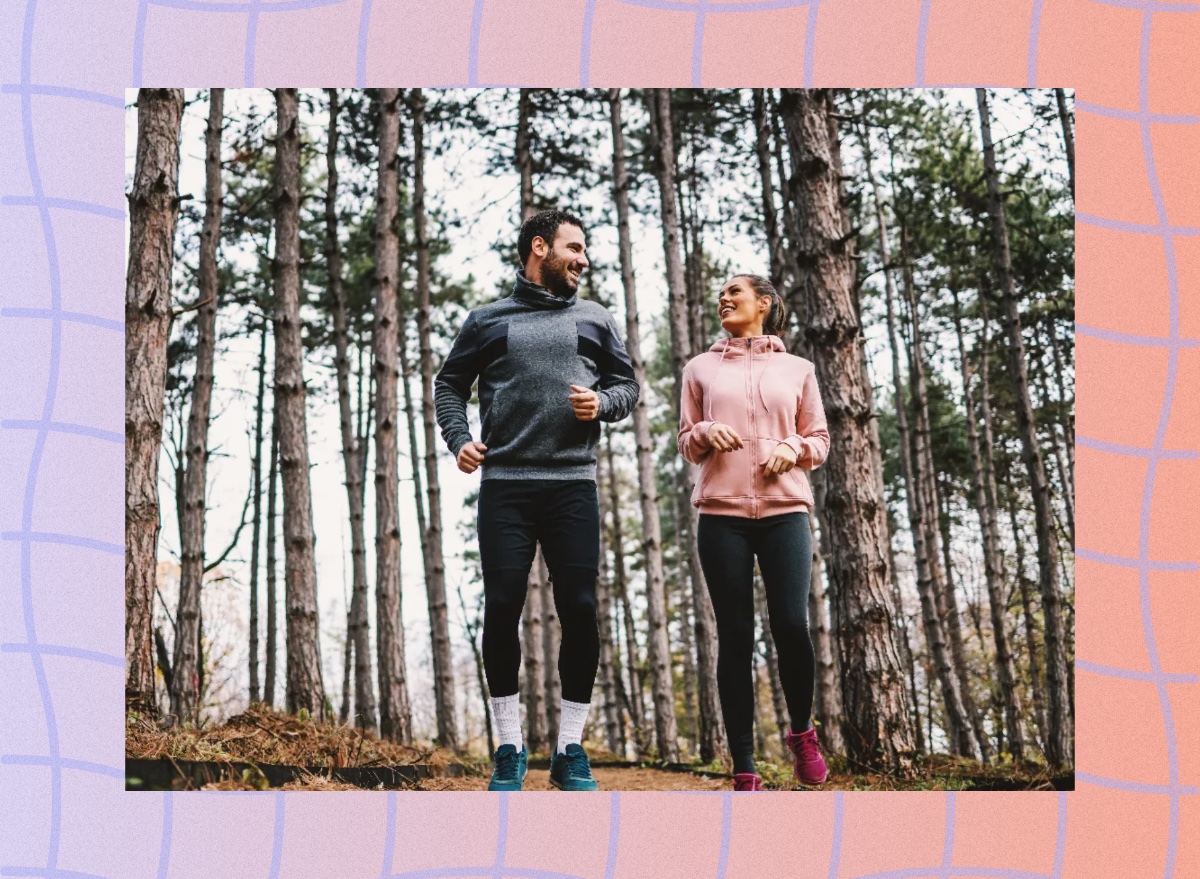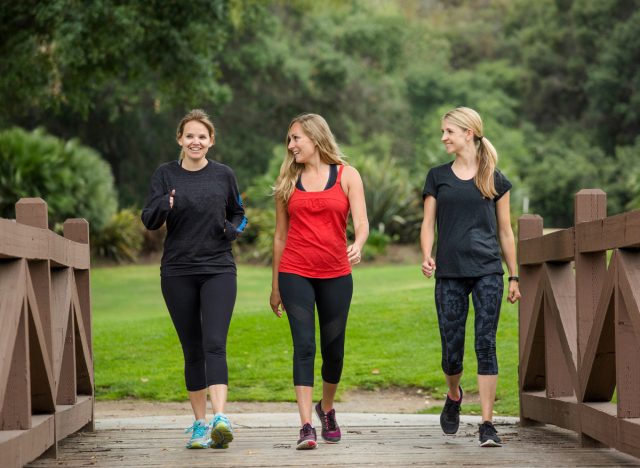Fitness
Ramp It Up: Punchy Intervals | 40 Minute HIIT Indoor Cycling Workout

Conor brings you another tough HIIT training session. There are lots of short, sharp, punchy intervals, ramping up in duration from 30 seconds at the start to 2 minutes at the end. Make sure you’ve got a towel and a drink ready!
Session breakdown:
00:00 – 1 mins @ 2/10 (80 rpm)
01:00 – 1 mins @ 3/10 (80 rpm)
02:00 – 2 mins @ 4/10 (80 rpm)
04:00 – 1 mins @ 5/10 (80 rpm)
05:00 – 1 mins @ 2/10 (80 rpm)
06:00 – 30 secs @ 8/10 (80 rpm)
06:30 – 1 mins @ 2/10 (80 rpm)
08:00 – 30 secs @ 8/10 (80 rpm)
08:00 – 1 mins @ 2/10 (80 rpm)
09:00 – 30 secs @ 8/10 (80 rpm)
09:30 – 1 mins @ 2/10 (80 rpm)
10:30 – 30 secs @ 8/10 (80 rpm)
11:00 – 2 mins @ 4/10 (80 rpm)
13:00 – 1 mins @ 2/10 (80 rpm)
14:00 – 1 mins @ 8/10 (80 rpm)
15:00 – 1 mins @ 2/10 (80 rpm)
16:00 – 1 mins @ 8/10 (80 rpm)
17:00 – 1 mins @ 2/10 (80 rpm)
18:00 – 1 mins @ 8/10 (80 rpm)
19:00 – 1 mins @ 2/10 (80 rpm)
20:00 – 1 mins @ 8/10 (80 rpm)
21:00 – 2 mins @ 4/10 (80 rpm)
23:00 – 1 mins @ 2/10 (80 rpm)
24:00 – 2 mins @ 8/10 (80 rpm)
26:00 – 1 mins @ 2/10 (80 rpm)
27:00 – 2 mins @ 8/10 (80 rpm)
29:00 – 1 mins @ 2/10 (80 rpm)
30:00 – 2 mins @ 8/10 (80 rpm)
32:00 – 1 mins @ 2/10 (80 rpm)
33:00 – 2 mins @ 8/10 (80 rpm)
35:00 – 2 mins @ 2/10 (80 rpm)
37:00 – 1 mins @ 5/10 (80 rpm)
38:00 – 2 mins @ 2/10 (80 rpm)
Useful Links:
Everything Cycling. All In One Place 👉 https://www.globalcyclingnetwork.com
Visit the GCN Shop 👉 https://gcn.eu/blackfriday23
Join the GCN Club 👉 https://gcnclub.com
GCN Training Plans 👉 https://gcn.eu/gcntp
🎵 Music – licensed by Epidemic Sound 🎵
Not all exercises are suitable for everyone – there is no ‘one size fits all’ approach. As with any strenuous exercise, you should take into account factors such as your flexibility, strength and overall health to determine if an exercise is appropriate for you, and consult a doctor/physician before beginning a programme of exercise. Discontinue your exercise session immediately if you experience any pain, dizziness or discomfort.
Partaking in training sessions following GCN’s video instruction is entirely at your own risk, and Global Cycling Network, its partners and its affiliated companies cannot be held responsible for any injuries which may occur as a result of these exercises.
More workouts with GCN: https://gcn.eu/gcntraining
#gcn #gcntraining #cycling #cyclingworkout #bikeworkout #workout #training #indoorcycling #indoortraining
The Global Cycling Network (GCN) is the largest online cycling channel in the world, bringing together a global community of road cyclists to celebrate everything that’s great about the world of cycling.
Our videos bring fans compelling daily content including expert tutorials, techniques, training, racing, cutting-edge bike tech, unparalleled behind the scenes event coverage, humour, entertainment, and more.
Presented by ex-pro riders, GCN offers a uniquely qualified insight into the world of cycling, and most importantly it’s fuelled by our passionate and enthusiastic fans – everyone who makes up the GCN community. We also bring the latest and greatest tech to your attention, showcase the best places in the world to ride and get exclusive access to events and races.
Welcome to the Global Cycling Network | Inside Cycling
Thanks to our sponsors:
Pinarello Bikes: https://gcn.eu/Pinarello
Canyon Bikes: http://gcn.eu/-Canyon
Pirelli Tyres: https://gcn.eu/Pirelli
Orbea Bikes: http://gcn.eu/Orbea
Vision Wheels: http://gcn.eu/Vision
Wahoo Fitness: http://gcn.eu/Wahoo-Fitness
Elite Bottles: https://gcn.eu/EliteBottles
Selle Italia: https://gcn.eu/SelleItalia
Zwift: https://gcn.eu/Zwift
Shimano Wheels: https://gcn.eu/Shimano
Shadow Stand: https://gcn.eu/ShadowStand
Watch our sister channels:
Global Cycling Network – https://www.youtube.com/globalcyclingnetwork
GCN Tech – https://www.youtube.com/gcntech
GCN Racing – https://www.youtube.com/gcnracing
Global Triathlon Network – https://www.youtube.com/gtn
GCN Italia – https://www.youtube.com/gcnitalia
GCN en Español – https://www.youtube.com/gcnenespanol
GCN auf Deutsch – https://www.youtube.com/gcnaufdeutsch
GCN en Français – https://www.youtube.com/gcnenfrancais
GCN Japan – https://www.youtube.com/gcnjapan
Global Mountain Bike Network – https://youtube.com/gmbn
GMBN Tech – https://www.youtube.com/gmbntech
Electric Mountain Bike Network – https://www.youtube.com/embn

Fitness
Best walking workout: Here's how to start walking for exercise
If you’ve been away from the exercise game for a while, it can be intimidating to get back into it, especially figuring out where to start. And if you’re trying to decide between the latest group fitness class or online workout program, you may end up being overwhelmed by options. To get started on your way to health without running into roadblocks (so to speak), walking is a great entry point for initiating a new routine. And as a running coach, I have many of my clients start their journeys with walking or combination walk/jogging routines to gradually build up their condition. The reality is, walking workouts are a convenient and accessible form of exercise that provide many health benefits and don’t require much to get started.
“Incorporating a regular walking routine, even as little as 30 minutes a day, can lead to significant improvements in both physical and mental health,” says Dr. Soma Mandal, a New Providence, N.J.-based board-certified internist and women’s health specialist at Summit Health. “It is an exercise that I frequently recommend to my patients, given its versatility and ease of integration into various lifestyles.”
Benefits of walking for exercise
Walking is already something you likely do every day, just to get through your day. According to Mandal, walking as a workout is one of the most accessible and beneficial physical activities that individuals can incorporate into their daily routines. “Physically, regular walking helps improve cardiovascular health by lowering blood pressure and cholesterol levels, reducing the risk of heart disease and enhancing overall circulation,” she says. “It also aids in maintaining a healthy weight, strengthening bones and muscles and improving joint flexibility, which can be particularly beneficial as we get older.”
And while walking is generally one of the most simple exercises you can perform, according to Ani Oksayan, a Carlsbad, Calif.-based certified personal trainer and the vice president of fitness at Chuze Fitness, it’s also one of the most direct paths toward significant positive changes to your overall well-being. “Walking burns calories, contributing to weight loss (or maintenance) and has a boosting effect on metabolism,” Oksayan says. “If you experience joint pain or arthritis, walking can promote significant improvement as it strengthens bones, keeps joints flexible and lubricated and strengthens surrounding muscles.”
But it’s not just good for your body, it’s good for your mind too. Research shows that walking provides mental and emotional benefits, as simply being outside can help lift your spirits and decrease stress. Mandal says that exercise in general can improve cognitive function and memory and promote better sleep patterns, which are crucial for mental well-being.
“Walking is known to boost mood and alleviate symptoms of anxiety and depression, largely due to the release of endorphins, which are natural mood lifters, during physical activity,” Mandal says. “It can also foster a sense of community and social interaction when done with others, further enhancing its psychological benefits.”
Getting started
You don’t need much to start a walking program, but a good pair of walking shoes is a must. (Getty Creative)
While walking might seem like a simple enough activity to get into, if you’ve been sedentary for a while, it’s wise to consult with your physician, just like with any new exercise routine, Mandal says. “This is particularly important if you have underlying health conditions such as heart disease, diabetes or joint issues,” she explains.
Mandal recommends that once you’ve gotten the all-clear, start with short walks, about 10-15 minutes long, then gradually increase the duration and intensity as your endurance improves.
“Aim for at least 150 minutes of moderate-intensity walking per week, as recommended by health guidelines, which can be broken down into sessions most convenient for you,” Mandal says.
Mandal also advises setting achievable goals that align with your lifestyle and current fitness level. Things like varying your route and listening to music or podcasts can help to make walks fun and enjoyable.
“Focus on consistency rather than intensity at the beginning, and celebrate small milestones to maintain motivation and enjoyment,” Mandal says. “Using a journal or app to track your walking can help keep you motivated and allow you to set and monitor goals, and apps like MyFitnessPal or Strava are popular choices for tracking fitness activities.”
While it’s possible to walk in everyday clothes and shoes, you might find you’re more comfortable doing walking workouts in activewear and sneakers made for walking. And if you have personal obligations such as caring for children during the day, having a treadmill in your home or using one at a gym can be an efficient way to complete your walking routine when it’s convenient for you, Oksayan adds. You can also increase your daily step count by using a walking pad while working or watching TV. These low-cost and low-profile treadmills are an effective way to get in a walking workout at home.
Creating a walking plan using the ‘FIT formula’
Oksayan recommends beginning a walking routine by applying the “FIT formula,” which is comprised of the elements of frequency, intensity and time. As you’re getting started, these elements can be applied conservatively. While a good goal is to walk at least 30 minutes, most days a week, you can start with the intention of simply walking as much as is possible for you, adding small increases to your time or intensity as your fitness and stamina improve, she says.
“It is a reasonable approach to try to walk every day but if you need to start more gradually, an average of three to five days per week is a good place to begin,” Oksayan says. “In terms of intensity, the goal is to walk at a moderate speed, generally paced at approximately 2 to 3 miles per hour; however, it is perfectly acceptable to start slower and build up your pace as is appropriate for you.”
There are several ways to gauge whether or not your walking intensity is where it should be to achieve the cardiovascular, weight management or mental health benefits you’re striving for, Oksayan adds. These include:
-
Using the “talk test.” Try talking as you walk — if you find it reasonably easy to carry on a conversation without losing your breath, you’re likely walking at a moderate intensity. If you struggle to hold a conversation, your intensity level is likely vigorous. If you find it easy to sing? It’s probably time to increase your speed — you’re probably walking at a low-intensity pace.
-
Measuring your heart rate. This is easiest to do while wearing a heart rate monitor or a fitness tracker. Using the tracker to help estimate your maximal heart rate (generally calculated as 220 – your age), aim to work at 50-70% of your max when exercising at a moderate intensity, or between 70-85% of your max if you want to walk vigorously.
-
Gauging your rate of perceived exertion, or RPE. This is a subjective scale measured between 0-10 for how hard you feel you’re working, with 0 being no effort at all and 10 being a maximal level you couldn’t sustain for more than a few seconds. If you feel you’re working at a 4-5, that’s considered moderate intensity. If you’re exercising at a 6-8, you’re likely exercising vigorously.
-
Monitoring your sweating and breathing. This is less effective for outdoor workouts where factors like temperature, air conditions and humidity can affect your sweat rate and breathing, but may be effective for indoor workouts where the environment is more controlled. Simply gauge how hard you’re breathing or how much you’re sweating, as these both increase with increasing intensity.
If you’re just starting out, a good walking program might look like:
-
Frequency: 5 days of walking per week
-
Intensity: Moderate intensity exercise based on a heart rate at 60% of my maximum heart rate
-
Time: 30 minutes of walking a day broken into 2, 15-minute walks, one before breakfast and the other after dinner
After successfully completing your program for a month, it might be time to revisit your plan and determine if you can increase the intensity or time dedicated to your walking workout.
Maximizing your walking workout
As your fitness improves, consider adding strength exercises periodically throughout your walking routine. (Getty Creative)
Walking is fortunately simple enough that you don’t have to be overly worried about things like injury prevention (although a good pair of shoes and a concentration on posture will help in this area). “Simple things like doing periodic posture checks, deep breathing and consciously relaxing the shoulders, hands and face while walking can combat building tension and misaligning posture,” Oksayan says. “Try to avoid slouching, overstriding tensing [your] hands and shoulders or looking at your feet while walking.”
Incorporating additional activities like strength training can also enhance overall fitness, Mandal adds. “Strength training helps build muscle and bone strength, which are crucial for overall health,” she says. “Yoga can complement your walking routine by improving flexibility and overall fitness levels.”
Additionally, while hydration is more critical during intense exercise like running, it’s still important to stay hydrated while walking, especially in hot weather or during longer walks, Dr. Mandal adds. Consider grabbing a water bottle that’s conducive to carrying with you on your walks.
Staying motivated
As with any activity, walking can quickly get boring and monotonous if you don’t mix things up every once in a while. It may not seem obvious, but you can find creative ways to incorporate variety into a walking routine to keep it enjoyable and help maintain consistency, Oksayan says. This includes things like using the incline feature on a treadmill, allowing you to walk hills and create more interesting rolling terrain, or adding intervals of increased speed to add intensity, which you can also do by power walking outside.
“Exercises like pushups against park benches, squats or lunges allow you to mix in a bit of strength training, maximizing the beneficial effects of your workout,” Oksayan suggests. “Walking with a group or a friend can have a beneficial effect on your walking routine, as exercising with friends, family or groups provides an opportunity for social interaction, which has been shown to improve mental health and well-being.”
FAQs
How many calories does walking burn?
According to Oksayan, the number of calories you burn during any form of exercise is dependent on a number of factors, including your weight, gender, age and body composition or muscle mass. Another factor that directly affects caloric burn is the intensity of the activity — in other words, the harder you work, the more calories you burn.
“This is true with walking in that the caloric burn will depend on how fast and long you walk, your body type and even the surface you walk on,” she says. “[That said], an average number for calories burned during a 30-minute walk at 3.5 miles per hour is 107 to 159 for a person weighing 125 to 185 pounds, but this can vary based on additional factors.”
Is walking enough exercise?
Depending on your goals, current health and approach, walking can be enough exercise for many people, Oksayan says.
“When done with a moderate to vigorous approach, it is effective in burning calories and helping to lose or maintain weight,” she says. “Walking, especially uphill or on uneven terrain, strengthens muscles in the lower body and can have an effect on improving balance and bone density.”
As we age, it becomes important to perform activities that can improve balance, flexibility and posture, and walking addresses these factors by promoting coordination and balance, strengthening your core and encouraging upright posture, Oksayan adds. In certain cases, however, walking may not be enough to achieve certain fitness goals if they are based on significant muscle gain, sports performance or rehabilitation. In those cases, walking could be complemented by more intense strength and cardio training.
Can I walk every day?
In a word, yes. Walking is easy to incorporate every day, whether it’s with a focused workout or while multitasking such as by walking to complete an errand.
“Movement every day is imperative, and walking can be incredibly beneficial for both your physical and mental health,” Oksayan says.
What are some good walking apps or resources?
While walking is fairly easy to do on your own, you can add more variety by incorporating guided workouts from apps such as Peloton, iFit, Aaptiv and Nike Training Club.
Meet our experts
Our health content is for informational purposes only and is not intended as professional medical advice. Consult a medical professional on questions about your health.
Fitness
Why The 'Silly Little Walk' Will Be Your New Favorite Exercise

There’s a productive exercise trend making waves on social media, and it’s called the “silly little walk.” It’s extremely easy to do and requires no equipment other than a solid pair of walking shoes. It’s gained quite a bit of attention under the #sillylittlewalk hashtag on TikTok—for good reason. The fitness trend starts by getting up and taking a little stroll outside, but we won’t spoil all the fun just yet!
Below, we outlined everything you need to know about the “silly little walk” workout trend and how to get started.
In This Article:
What Is the Silly Little Walk?

This outdoor walking trend prides itself on something to do that will make you feel better—mentally and physically—by getting active outside. (And we all know that some fresh air, vitamin D, and nature can work wonders on the mind, body, and soul!)
One TikToker dubbed her silly little walk “peace over everything,” while another TikTok user wrote in their video, “POV: You go on a silly little walk for your silly little mental health, and it actually works.”
Even when it’s incredibly cold outside, that’s no excuse—as long as your walking route is absolutely safe to walk, you’ll be so glad you carved out some time to do so. After all, everyone is hopping on the “silly little walk” bandwagon and reaping some pretty great physical and mental health rewards.
Now, as far as how you’d like to personalize your “silly little walk,” the sky really is the limit. You can opt for a few laps around your neighborhood, head to one of your favorite trails, see wherever your feet take you, or make plans to meet up with one of your besties as you enjoy your favorite caffeinated beverage, as a bunch of TikTokers are doing.
Catch up on your latest playlist while putting some serious distance to your outing, or even tailor your stroll to a personal “plogging” adventure. Every step you take counts, and hey—it’s healthy in more ways than one, so why not join in on the fun?
If you need a bit of inspiration, under the TikTok hashtag, you’ll find people documenting their walking routes and “silly little walk” adventures. The clips are likely to put a big smile on your face and motivate you to get up and active in the great outdoors.


Even when the temperatures are a bit chilly or you feel inclined to push off your workout to the next day, it’s important to still get your body up and moving. That’s where the silly little walk comes in clutch. It’s a stellar, low-impact way to add extra movement to your day while catching up with a friend or two—zero excuses!
Being social has a huge impact on your mental well-being. Research has proven that bonding with people plays a role in your health. As a matter of fact, being socially isolated can negatively impact you, both physically and psychologically. An article in the Journal of Health and Social Behavior notes adults who have a lot of social connections tend to be much healthier and lead longer lives than their peers who isolate themselves.
The Mental and Physical Benefits of the Silly Little Walk


By going on a silly little walk, you will get some valuable cardio and maybe even a bunch of laughs with friends. Reaping the benefits from physical exercise of any sort doesn’t mean the activity has to be a hardcore workout, either. A fun, brisk walk is all you need daily to increase your chances of maintaining a healthy lifestyle.
Walking will help you burn calories, along with maintaining or preventing several health disorders, such as high blood pressure, heart disease, diabetes, and cancer. In addition to giving you a solid energy boost, walking can help strengthen your bones and muscles and enhance your balance and coordination.
A strong walk will bring your anxiety and stress levels down and put you in a much better mood. You will sleep better, too!
Researchers at the University of California studied almost 6,000 women who were 65 years of age and up. The study revealed that women who walk more often are less likely to experience a memory decline from age. More specifically, 17% of the women who walked the most on a weekly basis experienced memory decline, compared to 24% of the women who walked the least amount in the study.
Another previous study published in the Proceedings of the National Academy of Science concluded that participants who took a 90-minute nature walk experienced less activity in the part of the brain that’s connected to one’s risk of developing a mental illness.
So even when it seems like you have absolutely no extra time in your schedule, do yourself a favor and get outside for a “silly little walk!” Your mind and body will certainly thank you—and getting active in the fresh air will feel so rejuvenating.
Alexa Mellardo
Fitness
“Consistency is key” when it comes to keeping you fitness resolutions

MERIDIAN, Miss. (WTOK) – A new year means new resolutions, and one of the more common resolutions is getting fit and going to the gym.
Losing weight and getting fit sounds easy, but both are difficult tasks to complete.
That’s why many people end up not following through with their resolutions just weeks after making them.
A local personal trainer says going to the gym is not the only thing you should do.
He says that watching what you eat is a good step on top of regular physical exercise.
“The main thing is thinking about your health being more healthy is a big thing around in. Just trying to come in try to work on being healthy and trying to get back into it. Get back to the groove. The main thing is being consistent. Consistency is key. As long as you’re coming to the gym and just doing what you need to do to try to reach your goals consistently will get you there,” said Personal Trainer Manager at Club4 Fitness Tevin Roberts.
Roberts also says to have smaller goals put in place so you can see gradual changes in your health and fitness journey.
“Never be embarrassed. You know what you’re trying to do when you come to the gym. Make sure you keep your goal in mind. Make sure you are know what you’re doing when you come to the gym. So keep that in mind and focus on what you’re trying to accomplish. Worry about no one around you,” said Roberts.
Click here to subscribe to our daily newsletter!
Copyright 2025 WTOK. All rights reserved.
-
/cdn.vox-cdn.com/uploads/chorus_asset/file/25672934/Metaphor_Key_Art_Horizontal.png)
/cdn.vox-cdn.com/uploads/chorus_asset/file/25672934/Metaphor_Key_Art_Horizontal.png) Technology1 week ago
Technology1 week agoThere’s a reason Metaphor: ReFantanzio’s battle music sounds as cool as it does
-

 News1 week ago
News1 week agoFrance’s new premier selects Eric Lombard as finance minister
-

 Business1 week ago
Business1 week agoOn a quest for global domination, Chinese EV makers are upending Thailand's auto industry
-

 Health5 days ago
Health5 days agoNew Year life lessons from country star: 'Never forget where you came from'
-
/cdn.vox-cdn.com/uploads/chorus_asset/file/24982514/Quest_3_dock.jpg)
/cdn.vox-cdn.com/uploads/chorus_asset/file/24982514/Quest_3_dock.jpg) Technology5 days ago
Technology5 days agoMeta’s ‘software update issue’ has been breaking Quest headsets for weeks
-

 World1 week ago
World1 week agoPassenger plane crashes in Kazakhstan: Emergencies ministry
-

 Politics1 week ago
Politics1 week agoIt's official: Biden signs new law, designates bald eagle as 'national bird'
-

 Politics7 days ago
Politics7 days ago'Politics is bad for business.' Why Disney's Bob Iger is trying to avoid hot buttons













